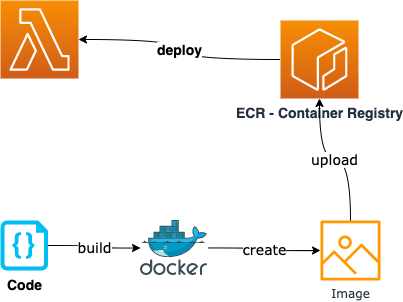Lambda container deployment

For using containers as an deployment option, these steps have to be performed, if you already have a Lambda resource with configured container image deployment:
- Call Docker to build the app and create the container image locally
- upload the image to ECR - the AWS container registry
- deploy the ECR stored image to lambda
All these steps will be performed by the CDK, see the chapter walkthrough for details.
The CDK Construct
See infra/lambda-go-arm.go from the source.
awslambda.NewDockerImageFunction(stack,
aws.String("RegisterHandlerAmd"),
&awslambda.DockerImageFunctionProps{
Architecture: awslambda.Architecture_X86_64(),
FunctionName: aws.String("hellodockerx86"),
MemorySize: aws.Float64(1024),
Timeout: awscdk.Duration_Seconds(aws.Float64(300)),
Code: awslambda.DockerImageCode_FromImageAsset(&dockerfile, &awslambda.AssetImageCodeProps{}),
})
The CDK supports the new Architecture type and the container deployment.
The architecture which Lambda runs in the configured here:
Architecture: awslambda.Architecture_X86_64(),
And the deployment type is just defined here:
Code:awslambda.DockerImageCode_FromImageAsset(&dockerfile, &awslambda.AssetImageCodeProps{}),
The Dockerfile
See appx86/Dockerfile from the source.
1 FROM public.ecr.aws/lambda/provided:al2 AS build
2 ENV CGO_ENABLED=0
3 RUN mkdir -p /opt/extensions
4 RUN yum -y install go
5 RUN go env -w GOPROXY=direct
6 ADD go.mod go.sum ./
7 RUN go mod download
8 COPY . ${LAMBDA_TASK_ROOT}
9 RUN env GOOS=linux GOARCH=amd64 go build -o=/main
10 # copy artifacts to a clean image
11 FROM public.ecr.aws/lambda/provided:al2
12 COPY --from=build /main /main
13 ENTRYPOINT [ "/main" ]
AWS has its own public registry and provides Lambda images, which is pulled in line 1: This images is based on Amazon Linux 2.
1 FROM public.ecr.aws/lambda/provided:al2 AS build
On some linux system you need to disable C GO. On my MAC it was not needed.
2 ENV CGO_ENABLED=0
Get rid of the extension warning.
3 RUN mkdir -p /opt/extensions
Install GO for the build process.
4 RUN yum -y install go
You could also build locally and copy the binary. Using Docker makes it more predictable and repeatable on different machines.
Control how GO downloads sources.
5 RUN go env -w GOPROXY=direct
Only copy (add) the GO package files and download (get) all GO modules.
6 ADD go.mod go.sum ./
7 RUN go mod download
This copies “everything”, which now is only main.go for the build. The task root is the directory where Lambda runs code.
8 COPY . ${LAMBDA_TASK_ROOT}
Build binary with linux as target system and amd64 as the architecture - because that is what Lambda runs on.
9 RUN env GOOS=linux GOARCH=amd64 go build -o=/main
The GO installation is quite large. To keep the image small we do a fresh start
10 # copy artifacts to a clean image
11 FROM public.ecr.aws/lambda/provided:al2
Then we only copy the binary, that runs without external dependencies.
12 COPY --from=build /main /main
This tells lambda, which programm to start in invokation
13 ENTRYPOINT [ "/main" ]
Go to the next chapter to see Container deployment with arm architecture